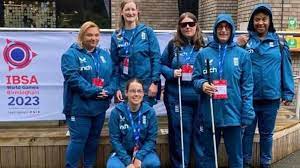UK: Birmingham hosts Blind Sport world games

Birmingham: Teams from all over the world are taking part in the International Blind Sport Federation World Games, the first time it has been held in the UK.
More than 1,250 blind and partially sighted athletes, taking part in 11 different sports, will compete at venues such as Edgbaston for the cricket finals, Coventry’s CBS Arena for the goalball and smaller venues such as Cafe Aroma at the University of Birmingham for chess.
This year’s games include, for the first time, women’s cricket.
Captaining England and preparing the side for Saturday’s match against Australia team is Kathryn Jelfs-White.
She was born with a congenital condition which has left her short-sighted and with no colour vision.
“But I have never known any different, so I just get through,” she said.
Her school, one for visually impaired pupils, did not do a lot of sport, she added, certainly not cricket, but she and her family used to watch it on television or go to a nearby ground to see a match.

“The first time I tried cricket I was in my 30s. I picked it up and quite liked it and I’ve been doing it ever since,” she said.
“We are deadly serious when we are on the pitch and we have some tough competitors in the squad. It’s an a achievement to be here and we are very proud.”
Jelfs-White has been playing internationally for six years, having started at a domestic level in 2010.
Team-mate Heidi Linegar introduced her to the game during sessions at Taunton Vale Sports Club.
Linegar, also short-sighted from birth, took up cricket in her 30s when working for a sight-loss charity. She has since played for Somerset’s sight-impaired team.
“The cricket ground helped us set up a development team and taster sessions,” she said. “Then it spread to people from other counties joining in and it just gave us something to do.
“There was a good social aspect to it too – some people do not get to meet other visually impaired people.”
International matches are different to domestic games, however.
In domestic cricket, a larger ball is used and bowlers throw overarm. Internationally, a smaller ball is used with an underarm throw.
The team has to have a certain number of completely blind players, who will use runners, as well as people who can run for themselves.
“Communication is really important for the game – you have to have people able to describe what’s happening to the ball, as well as the ball bearings so people can hear it,” Linegar said.
The game is tough on the body too.
“It’s quite physically demanding, we’re not just standing around,” Jelfs-White said. “The balls stay on the ground a lot so you are quite often down one knee.”





